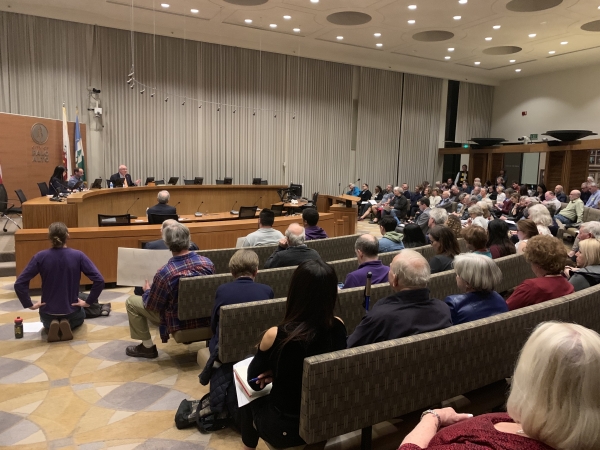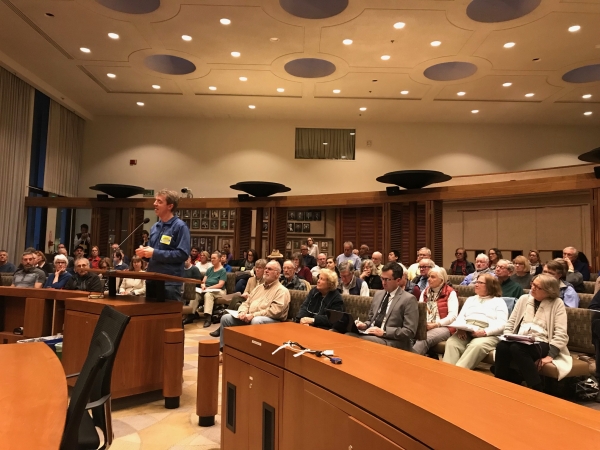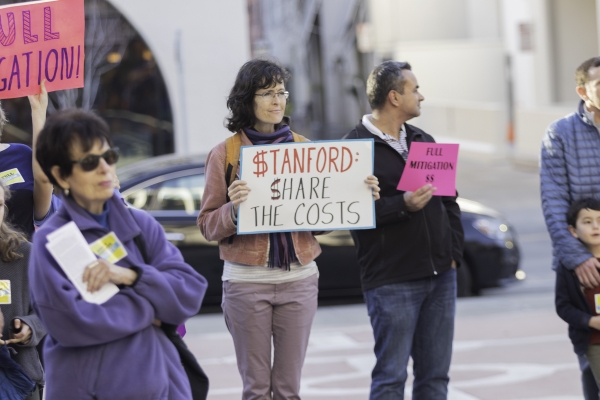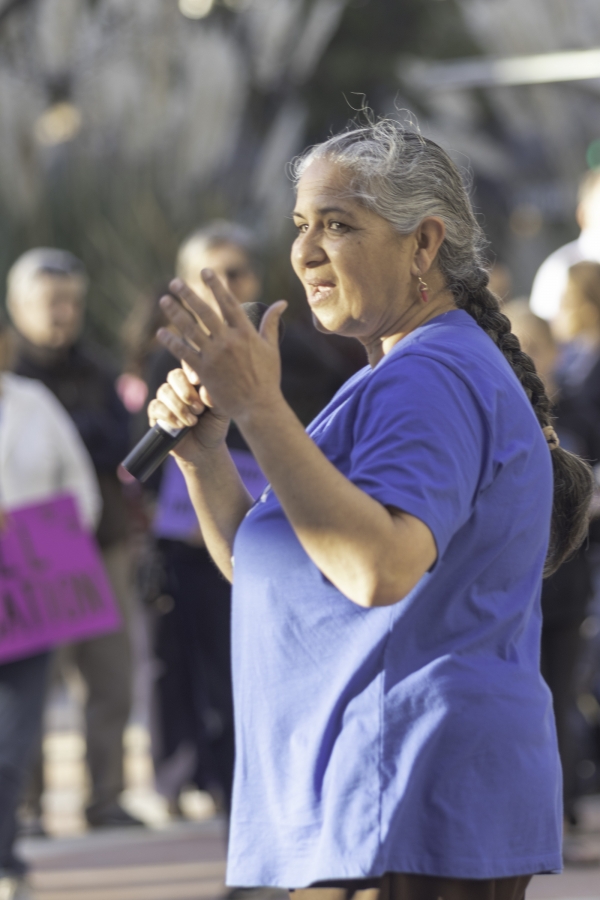Santa Clara County may require Stanford University to nearly quadruple the number of housing units it has to produce for its employees to secure permission for its ambitious campus-expansion plan.
The county this week released a set of conditions that staff recommends including as part of approval of Stanford's application for a new General Use Permit, a document and guide to the university's growth between now and 2035. Stanford is seeking the permit so that it can construct up to 2.275 million square feet of new academic space, 2,600 student beds and 550 units of housing for faculty and staff.
The county's new proposal, which is subject to approval by the Board of Supervisors, would upend Stanford's housing plan by requiring an additional 1,622 units of faculty and staff housing, for a minimum of 2,172 units, along with the 2,600 student beds that Stanford had requested. It would also allow the university to go beyond the minimum requirement and build up to 2,892 housing units and 2,807 student beds.
The county is also proposing a requirement that at least 70 percent of these units — a total of 1,520 faculty units — to be built on campus.
The proposal, which the county released on Tuesday and which board President Joe Simitian discussed in a Town Hall meeting Thursday at Palo Alto's City Council Chambers, also includes a 99-year prohibition on developing in the foothills (which can only be overturned by 4-to-5 vote from the board) and a revised methodology for tallying Stanford's traffic impacts, with more consideration of reverse commutes and a new emphasis on limiting the growth of average daily traffic.
The new General Use Permit, much like the one the Board of Supervisors approved in 2000, will require Stanford to meet a goal of "no net new car trips" on campus. But whereas the existing permit gauges Stanford's compliance by measuring trips during a "peak hour," the new permit would base it on a three-hour "peak period" under the county's proposal.
While all these conditions are yet to be reviewed by the board, at least one member has already embraced some of the key provisions in the staff recommendation. In explaining the county position on housing, Simitian noted Thursday that Stanford's expansion plan would bring an estimated 9,610 new people to the campus, according to the environmental analysis for the GUP. The student beds, he noted, would only take care of 2,600 people (assuming one person per bed). This, Simitian noted, leaves 7,010 people vying for the 550 units.
"I don't think 550 units of housing is sufficient to address the housing needs of those 7,010 people who are left over after we remove the beds," Simitian told the crowd during the Town Hall, which was sponsored by the Palo Alto Weekly. "This has been the source of discussion pretty much from Day One with respect to the proposal."
The list of conditions did little, however, to address the topic that many in the community turned out to hear about: the impact of Stanford's growth on the Palo Alto Unified School District. Prior to the meeting, dozens of residents, including parents, students, school district officials and City Council members, rallied outside City Hall at King Plaza to demand "full mitigation" from Stanford, a phrase that Simitian also used in describing his goals for the project.
The list of conditions only calls for Stanford to relocate a designated school site from the east side of the campus to the west side. It does not, however, require the university to either contribute funding to the school district or to help it build a new school to serve the expected influx of students.
Simitian said that is a function of state law, which limits the county's ability to address school impacts as part of its environmental-review process.
"We don't have as many tools as we would like in the land use process to help our schools," Simitian said at the rally before the Town Hall. "We can address traffic, we can address housing, we can address open space protection, but what we don't have by virtue of state law is a lot of tools to help us help our local schools and the kids they serve."
Simitian expressed some hope, however, that the school district and Stanford will be able to reach an amicable resolution on school impacts in the coming months. He cited the freshly launched between the two parties as of evidence change in their university's posture.
The Board of Education had approved last November a resolution requesting that Stanford provide funding and assistance with building a new school. Stanford's unwillingness to commit to these measures has frustrated many on the school side.
On Tuesday, however, Superintendent Don Austin said the district and Stanford had agreed to start confidential discussions about benefits and mitigations.
Jean McCown, Stanford's assistant vice president and director of community relations, said in a statement Thursday that the university "will seek to have the results of direct discussions between PAUSD and the university included as community benefits in the final agreement with the county."
Simitian said he sees the restart of the negotiations as a positive sign.
"I, for one, welcome the evolution of thinking that has led to that," Simitian said during the Town Hall. "If there has been a turnaround on this issue, good! Great!"
The Board of Supervisors is also expected to broach the subject of school impacts during its own negotiations with Stanford University on a development agreement, a process that is headed by Simitian and Supervisor Cindy Chavez. The agreement will afford both sides more flexibility than the EIR process to propose mitigation strategies and community benefits that could be included as part of the expansion plan.
Stanford is unlikely to embrace the county's recommendation for more faculty and staff housing. Catherine Palter, associate vice president for land use and environmental planning, said in a statement Thursday that the university's proposal — which includes 550 units and 2,600 student beds — is based on a "careful planning process" and represents a "reasonable, responsible and paced approach, consistent with our values as a residential university committed to sustainable development and service to the community."
"We are proposing an amount of new academic space consistent with the university's historic growth rate, and 3,150 housing units and student beds, 550 of which would be subsidized apartments close to public transit for faculty and staff," Palter said. "The analysis in the county's final environmental impact report validates the careful planning that went into the 2018 General Use Permit application. The result of that process is a proposal that we feel balances the needs of the university and the community while addressing potential impacts over the life of the permit."







Comments
another community
on Mar 17, 2019 at 8:46 pm
on Mar 17, 2019 at 8:46 pm
Why does Stanford dictate what will happen? They seem overly in control - whereas their lack of housing - and opposition to contributing appropriately to public schools - and head-in-sand attitude about their increased auto traffic are all insults to the local communities here.
Registered user
Rengstorff Park
on Mar 27, 2019 at 9:22 pm
Registered user
on Mar 27, 2019 at 9:22 pm
I'm a proud Stanford alumnus, and I say, if Stanford doesn't have room for the students, the workers, and the schoolkids, then it doesn't have room for the new academic space. Stanford is just as much a part of the Bay Area 's devastating jobs-housing imbalance as any other city.